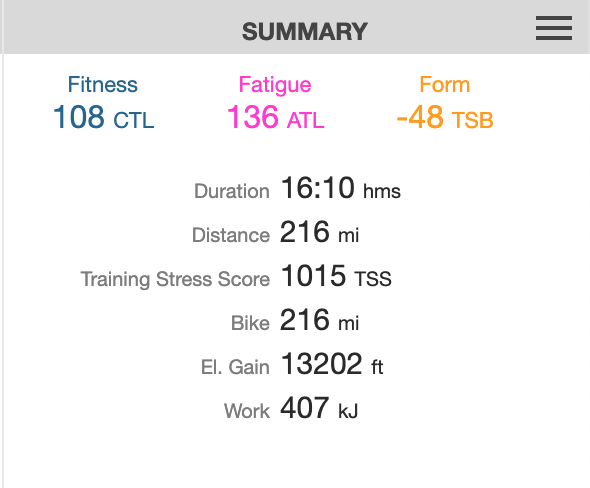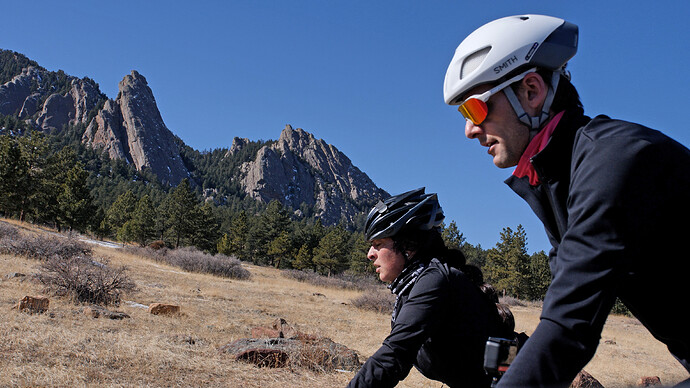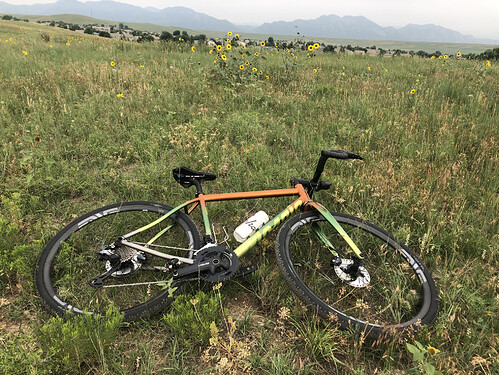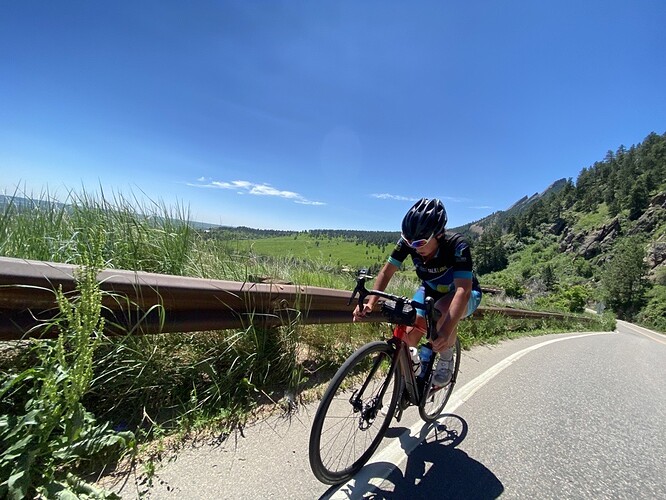I wish WKO had the hrTSS metric so I can compare to TSS…But maybe I need to get more in tuned to that pw:hr metric…
@ryan thank you for these kind words! Your encouragement as we raced along the roads helped me focus on my effort.
@murphyy12, good luck with your April racing. That’s coming up soon! What do you like best about the strength sessions and progress you’ve seen so far?
@bgkeen sounds like a pretty awesome year of travel that you have lined up so far! Love that you get to ride in Lebanon. Is the riding good there?
@jana - I have been focusing on just the basics at this time with a lot of help from Menachem Brodie videos (Human Vortex Training). I have been focusing on glute activation (something I desperately need). I also like the Sufferfest beginner level strength sessions which really focus on balance and technique. I have noticed better posture in my job (desk job) and on the bike as well as better glute engagement.
Training Update! I have taken my INSCYD test in order to learn, for the first time, what my strengths and weaknesses are as an athlete. Now that I have my results, I have a baseline of knowledge about my physiology. This means I can start applying all of the knowledge I’ve gleaned from @trevor, @chris, @colbypearce, @ryan, and all of our fantastic podcast guests over the past year.
As I anticipated, the pacing was tricky, but thanks to @ryan’s coaching I was able to start learning the levels to my efforts. Pacing the two longer efforts in the protocol of the INSCYD test was more difficult for me than the all-out efforts of the 20 sec and 3 min.
Now that I have results, as @ryan kindly mentioned above, what will I do with this influx of data and information? My focus over the next few months will be to optimize both my health and performance by:
- Refining nutrition
- Adding volume
- Adding intervals
- Learning pack-riding skills
A big part of my race preparation will be simply learning since this is all new. I decided to revisit Fast Talk episode 49: Training, Fueling, and Suffering at Dirty Kanza 200, which details how Trevor coached Chris leading into the 200-mile gravel race across the Flint Hills of Kansas now known as Unbound.
My big takeaway from this episode: I better get serious about my training! I know from my past competitive experiences as a figure skater that the better trained and prepared you are, the more enjoyable your event will be.!
Your excitement and enthusiasm brings back fond memories from my first year of racing. Part of the fun is the constant progression you’ll see. That said, there will inevitably be ups and downs—and that can be fun in its own way if you learn to embrace the journey.
You’re going to learn so much because you have so many experienced athletes around you. And your lessons will become lessons for all, new racers and veterans, young and old. I’m so glad you’re stepping into this new world of endurance sports. It will probably, um, definitely change your life!
@jana
I have only had a chance to do 1 ride there on my visits there. There is not much bike infrastructure there, so, my typical rides to get to know places really are a possibility there in Beirut. But I think biking is becoming more popular. So, I am hoping for a 1-2 nice rides while there this time.
But there are mountains and I got a chance to rent a bike and meet up with a group there. The riding is much better than I thought. There are ski resorts that turn into summer fun areas with a lot of mountain biking and road biking. The route I did was a rolling out and back (which began with a 3 mile 1400’ climb to get to the start…ugh!). It was beautiful as we were on a ridge over the Bekka Valley. But we did have to cross a checkpoint a few times and had to stop for a tank to cross the road. I was told by the riders around me to “not say a word” and let them do any talking if needed…I guess I didn’t want to let on the I was American 
That’s really cool that you’ve noticed the effects of strength work even in how you sit at your desk. I have watched one of Menachem’s strength videos and found his thorough position explanation very helpful.
I recently moved and now have access to a community fitness center. Seems like the perfect opportunity for me to get back to some strength work myself. Thanks for sharing. Happy training!
This sounds very adventurous and kind of scary! Tanks and checkpoints! Wow. Good luck when you go back. The climb sounds brutal, but epic. Would be cool to see some photos of what it’s like riding there (if you can get a safe shot, that is!)
GO JANA GO 

I will definitely try to get some nice pictures and share!
@ryan
I have another question regarding the protocol, since I am always for being a guinea pig and suffering and submitting data to learn not only about me but learning another protocol and what information the data gives…
As I am reviewing my focus and fitness (and recovering from a minor injury and a “valley” in my form) I am looking to do train for some long endurance events (read into this that I am honing in on my N1 to be something in the 200mile range) . I am sure I can do a few blocks for trying crush a 12 minute TT to get through the test but that will not help for what I am planning in a few months.
I am wondering what the “state” I should be in related to what the results will tell me? Should I just do it with a few days rest and results will tell me some things that are natural to me? Or if I did a few blocks of focus training will it tell me how I am related to the “prep”? I guess will it tell me more about what is natural to me or how I prepped going into it?
Thanks
Brian
Hey @bgkeen, great question and dedication to the N1/guinea pig ethos!
Wow, that’s a great, and big, N1 challenge to aim for that 200 mile range! Good for you!
To your question, I have gotten that many many times over the years with athletes coming into the lab for physiological testing. My response hasn’t changed one bit over the years simply because I haven’t found a reason to change it just yet. This (any protocol, really) will tell you your capabilities at that point in time. In your case, looking at something quite long for your N1, we would certainly have expectations of what your physiology and metabolism should look like for a good performance. So an initial test would give you that baseline and tell you those things that are natural to you. I think this is very valuable at any time of the year.
However, to your other point, if you did a block of preparation, then it would give you insight into those abilities after the prep period. My question would be: how do you compare that to your baseline/natural abilities? If you already have enough data to go off, then maybe you don’t need the baseline and you can train up for it to see what kind of changes you see. But if you don’t have a solid baseline, it could be worth getting a sense for those natural abilities first.
As an example, I did 2x INSCYD tests last year (one “INSCYD” and one “OUTSCYD”  ) and both told me what I already know. They also gave me important metrics that I didn’t previously have (e.g., VLamax). So now I’m slated to do another test in a week or so after a completely different winter period where I did much more base work and less time around threshold. I’m interested to see those changes. Since INSCYD does a great job of giving you data related to glycolytic capacity, that will be one area I want to keep an eye on. And with MLSS (maximal lactate steady state) being the comparison point for your anaerobic threshold in the system, I like comparing my baseline AT with this soon to come follow-up AT because it’s calculated the same way. Much better than comparing INSCYD’s AT with my FTP from a 20m test or MAP test, for example. Just the apples to apples thing.
) and both told me what I already know. They also gave me important metrics that I didn’t previously have (e.g., VLamax). So now I’m slated to do another test in a week or so after a completely different winter period where I did much more base work and less time around threshold. I’m interested to see those changes. Since INSCYD does a great job of giving you data related to glycolytic capacity, that will be one area I want to keep an eye on. And with MLSS (maximal lactate steady state) being the comparison point for your anaerobic threshold in the system, I like comparing my baseline AT with this soon to come follow-up AT because it’s calculated the same way. Much better than comparing INSCYD’s AT with my FTP from a 20m test or MAP test, for example. Just the apples to apples thing.
Ryan
Choosing Crooked Creek Gravel near Winter Park is very brave. It is one of the hardest rides around. I am sure you can get it done with Ryan’s help and persistence. Good Luck
Thanks @ryan. As I am honing in on what I am planning I think I am going to do a week or two of prep. Do a baseline, figure out my process for training for N1, and look to try another 1-2 tests to see where things are, like maybe a few weeks out from the event to see if I am in the ballpark to where I should be, and then later as the “season” is coming to an end to see where I compare late in the season as oppose to early/mid…Am I fried and “falling” or holding great from the season, etc…
I am excited to have this motivation to plan something big for myself and also some tests to put myself through!
Two more days until I race the 65-mile course of Crooked Gravel up in Winter Park, CO!
I’ve studied and made notes of the race-course and I’ve watched this video made by Roll Massif that explains a bit about the different surfaces, shows the course from the road, and even gives you a heads up on some of the trickier turns in the race.
I’ve ridden and ridden and ridden. Looking back on the past months of training I know I could have been smarter about the way I trained. I could have done more intervals; I could have eaten better; I could have …etc. You get it. There’s always more you “could have” done, and I find myself initially tempted to dwell on those missed opportunities, rather than focus on the great work that I did accomplish.
On Monday of this week, @ryan pointed out that my TSS was through the roof.

This was the first moment that I realized that my feeling of “not enough” was definitely misguided.
Contributing to this massive fatigue was a hard-steep ride in the 100-degree heat last weekend with @trevor. That plus the cumulative effect of the last 10 weeks of consistent riding, brought me to a halting stop. Sunday I could barely scrape up the energy to walk my lil pup around the neighborhood pond…sorry buddy!
I was warned last week by a colleague who has their own endurance training block experience that I might not feel great during this race-week taper. I’m not one to doubt, but last week I felt like the hulk, able to ride as much as Lachlan Morton himself…(yay Alt Tour for the win!) Now I know exactly what my friend was talking about. I’m exhausted. I attempted one ride yesterday and felt okay but overall this week I’ve been lethargic, despite the fact that I’m sleeping well; I have an insatiable appetite, and I’ve even felt a little foggy. Without that warning, I may have worried or stressed out to feel so exhausted days before my race, but I believe in the principles behind this training and I know that my body will bounce back given ample time to recover.
Take it easy because “it’s better to be 10% undertrained than 1% overtrained.” as @ryan put it to me the other day.
All this said I’m so excited to get on my sweet gravel-race bike, GT-1 (thanks Mosaic!) and hit the mountain hard on Saturday. This season I’ve learned so much about pacing (through my week-long Flagstaff PR attempts with the Mosaic crew,) fueling, gear, and consistency. I feel prepped and ready to race. ![]()
Good Luck and Have Fun!




